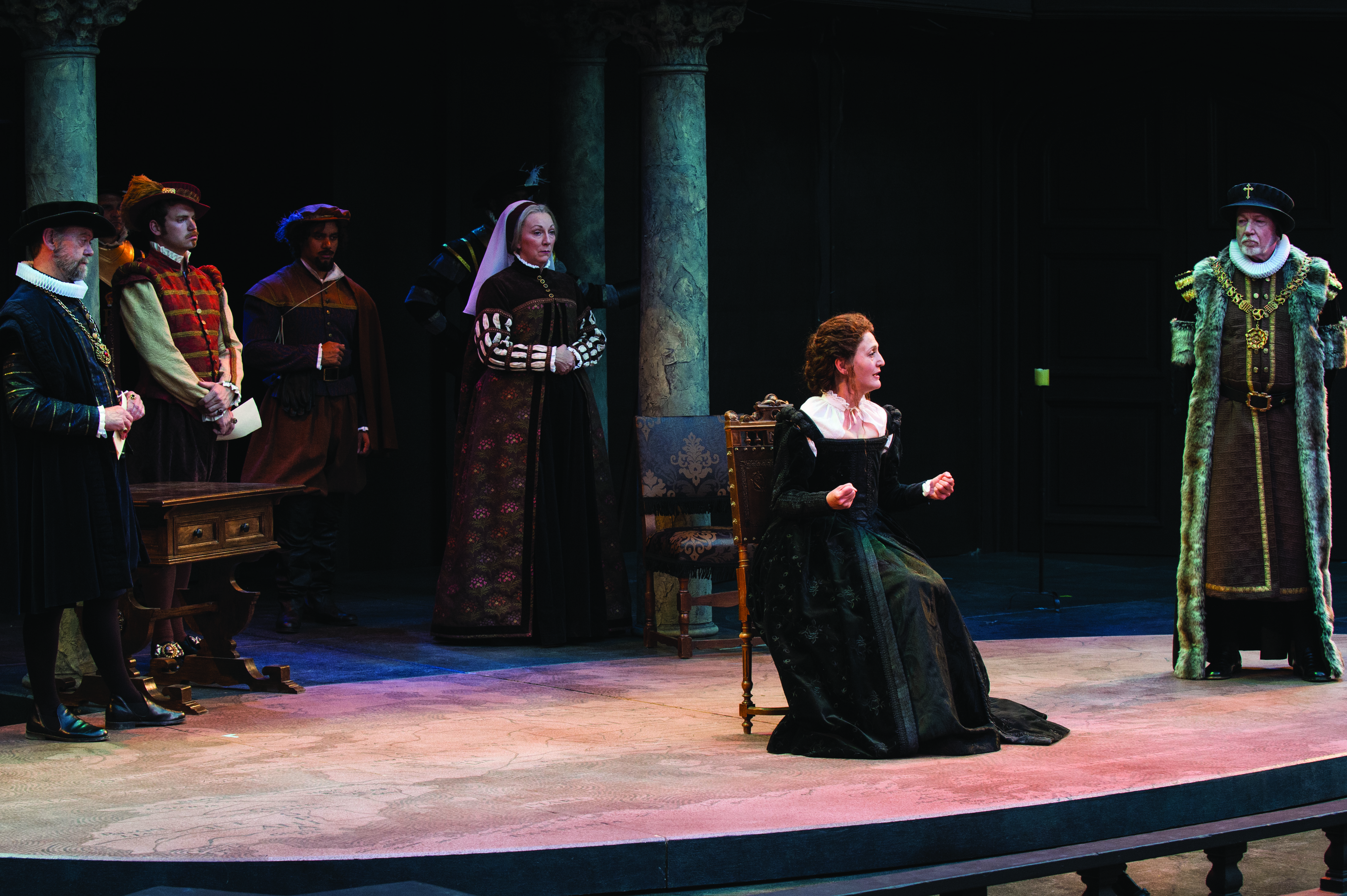CEDAR CITY — I was actually quite apprehensive about Mary Stuart when I arrived in Cedar City for the Utah Shakespeare Festival’s 2012 season. Usually the Festival produces three Shakespeare productions every summer in its Elizabethan-style outdoor theater. But this year, Mary Stuart replaced one of the Shakespeare productions in the Festival’s season, leaving only two Shakespeare plays (The Merry Wives of Windsor and Titus Andronicus) on the schedule. However, after seeing Mary Stuart, I must publicly admit that my fears about the production were unfounded—it stands firmly in its rightful place on the Adams Shakespearean Theatre stage. Mary Stuart has a cast of queens and noblemen, and a script that deals with weighty matters of state through gorgeous language. This play, and the production created by the creative staff at the Festival, can confidently and favorably be compared with the Bard’s works that are normally seen on the Adams stage.

Jacqueline Antaramian as Mary Stuart in the Utah Shakespeare Festival’s 2012 production of Mary Stuart. (Photo by Karl Hugh. Copyright Utah Shakespeare Festival 2012.) Show closes August 31, 2012.
Mary Stuart is a play by Peter Oswald (and adapted from an earlier play by Friedrich Schiller) that is based on the historical events surrounding the death of Mary, Queen of Scots. After turmoil in her own country of Scotland, Mary fled to her cousin Elizabeth I’s England. However, Mary had a legal claim to the throne of England, and while there she had incited rebellion against Elizabeth. When her insurrections were unsuccessful, Mary was tried and imprisoned by the English government. Guilty of treason, Mary should have been executed. However, her situation created a political problem: Mary was a sovereign queen and no European government had executed a monarch. Such an action would create a dangerous precedent, especially for Elizabeth. Elizabeth had come to power in the tumultuous Tudor era of England’s history and, for most of her reign, did not have an ironclad hold on her throne. Eventually, Mary was executed, with a multitude of consequences that reverberated throughout England for decades. (Indeed, the English parliament would later take advantage of this precedent to execute Charles I in the 17th century.)
The play revolves around the two queens, Elizabeth (Monica Bell) and Mary (Jacqueline Antaramian). With the help of director Kate Buckley, these women created characters that were far deeper than the staid vanilla sketches that emerge from history books or the bland painting style of the time. Instead, Bell created an Elizabeth who was a strong willed woman, determined to fight for her birthright and her nation, no matter the personal cost. When Elizabeth and Mary met in the park in the first half of the play, it became unmistakeably clear to me how Elizabeth would stand against Spain and France—the most powerful nations in the world at the time—and dare to have her little nation expand its reach beyond the British Isles. Similarly, Antaramian created a version of Mary that was simultaneously faithful to the character’s high social position as a queen, yet also conscious of her humbled stature as a prisoner. As played by Antaramian, Mary clung to every shred of dignity she could (especially in the opening scene when her quarters had been searched). She would not permit her captors to forget that she was born a queen and would conduct herself as such in all her dealings. I think both women’s portrayals were rich, entrancing, and completely appropriate for the story that they were asked to tell.

Monica Bell as Elizabeth in the Utah Shakespeare Festival’s 2012 production of Mary Stuart. (Photo by Karl Hugh. Copyright Utah Shakespeare Festival 2012.)
I was captivated by Steve Wojtas‘s portrayal of Mortimer. The character’s youthful exuberance and firm devotion to his cause were exceptionally believable. This is important because many of Mortimer’s actions drive the conflict of the play. I was quite pleased with Wojtas’s description of his character’s trip to continental Europe and its impact on his psyche. If Wojtas hadn’t been successful with this section of dialogue, much of the plot’s developments would have felt hollow, as if they were included in the play merely because they’re faithful to the historical milieu of the times.
The supporting cast was also highly entertaining. The remaining female character in the play, Hanna Kennedy, was endearingly played by Leslie Brott. Brott infused Hanna with a devotion that showed that her character was serving Mary out of sincere friendship, not merely because she was a hired servant. Martin Kildare played a mysterious Robert Dudley (the Earl of Leicster). His subtle, chameleon-like acting decisions had me guessing about his character almost to the very end of the play. Finally, I would be failing in my reviewing duties if I did not mention the performance of Dan Kremer as William Cecil (Lord Burleigh, the treasurer). Kremer created a character who was a consummate politician in any century: he supported his ruler, but never ceased to look after his own self-interest.
If there’s one thing the Utah Shakespeare Festival does well, it’s Renaissance costuming. Bill Black‘s designs effectively conveyed information about characters’ rank, power, and status. But the costumes were also gorgeous (especially the orange suit for Leicester) and appropriate for the time period, too. I also admired Mary’s hair (Krissa Lent, hair and make-up director), which helped express Mary’s careworn and desperate state.
As for the script, Shakespeare could have never written it. The English theaters of the day were subject to tight censorship, with contemporary political controversies being particularly taboo for the authorities. Unsurprisingly, Shakespeare’s final history play (Henry VIII) was written about 10 years after the death of the title subject’s last child—and when a completely different dynasty held the throne. For him to explicitly write a historical play about the death of Mary, Queen of Scots, would be unthinkable. But I see Mary Stuart as a sort of thought experiment where Schiller (and Oswald after him) tried to extrapolate what such a play would have looked like if Shakespeare had written about the subject. As such, the script is full of Shakespearean motifs, such as soliloquies and colorful metaphorical language. The script also treats themes that Shakespeare frequently visited in his work, such as the nature of monarchy and power. This is why I think the play fits so well on the Adams stage. I hope that other Utah patrons will not do as I did and pre-judge the work just because “it’s not Shakespeare.” It’s actually more Shakespearean than some plays written by the Bard’s contemporaries.

A scene from the Utah Shakespeare Festival’s 2012 production of Mary Stuart. (Photo by Karl Hugh. Copyright Utah Shakespeare Festival 2012.)






